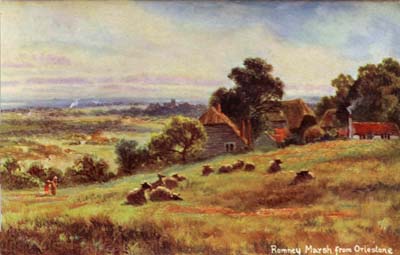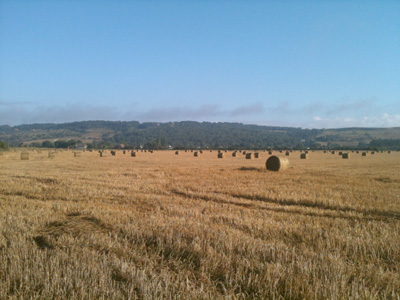
Top Apartment
Garden Apartment
Original Artwork
Dymchurch
Romney Marsh
Other places to visit
The Sea Wall
A Visitor's Tale
Further Info
Links
Prices and Availability
Contact Us


Dymchurch Beach:
Blue Flag Award 2022
ROMNEY MARSH
'The world, according to the best geographers, is divided into Europe, Asia, Africa, America and Romney Marsh.' In these words, the author of the Ingoldsby Legends provocatively suggests the extraordinary phenomenon of a 'fifth quarter of the globe,' and therein lies the magic and wonder of Romney Marsh.
The 'fifth quarter' is situated in the southern corner of Kent, and stretches on the seaward side from Hythe to Rye, and is bounded on the north by the Royal Military Canal, behind which is the irregular range of hills which mark the ancient coast line. It comprises some 50,000 acres, and is roughly ten miles broad and eighteen miles long. In point of fact, this area consists of three marshes, Romney Marsh proper, the largest and most easterly section, and the marshes of Walland and Denge, between New Romney and Rye.
Other corners of England may be better known for the magnificence of their scenery, but Romney Marsh has been famous for centuries as a place of infinite age, infinite mystery, and infinite peace.
In very early times this great tract of level land was one vast bay of the sea, over the waters of which vessels sailed up to the old fort and port where Lympne now stands. When Julius Caesar landed on the Kentish Coast he found a shallow estuary extending from the chalk cliffs at Fairlight to the ragstone hills at Lympne. At low tide this estuary became a stretch of muddy flats with occasional ridges of shingle and sandy islands deposited by the receding tides. As time went by these sandy islands became bigger, so that in Saxon days large tracts of land existed above high water level. This is proved beyond doubt by early Saxon charters and grants of land. To protect these sandy tracts from being washed away, skilful inning was carried out, massive earth walls were raised to resist the tide, and the natural shingle ridge along the shore was banked up so that gradually a drained and protected area came into being. During the wet season the streams from the hills brought down more soil, which spread itself over the sand and in time begin the growth of that rich green grass which has made Romney Marsh the envy of sheep graziers all over the world.
Go to the cliff on which stands historic Lympne Castle, and there look down on this great stretch of pastureland, with its rich green colouring, dotted with hundreds of white sheep, unforgettably level, and unbelievably English.

In Romney Marsh
As I went down to Dymchurch Wall,
I heard the South sing o'er the land
I saw the yellow sunlight fall
On knolls where Norman churches stand.
And ringing shrilly, taut and lithe,
Within the wind a core of sound,
The wire from Romney town to Hythe
Along its airy journey wound.
A veil of purple vapour flowed
And trailed its fringe along the Straits;
The upper air like sapphire glowed:
And roses filled Heaven's central gates.
Masts in the offing wagged their tops;
The swinging waves pealed on the shore;
The saffron beach, all diamond drops
And beads of surge, prolonged the roar.
As I came up from Dymchurch Wall,
I saw above the Downs' low crest
The crimson brands of sunset fall,
Flicker and fade from out the West.
Night sank: like flakes of silver fire
The stars in one great shower came down;
Shrill blew the wind; and shrill the wire
Rang out from Hythe to Romney town.
The darkly shining salt sea drops
Streamed as the waves clashed on the shore;
The beach, with all its organ stops
Pealing again, prolonged the roar.
John Davidson


